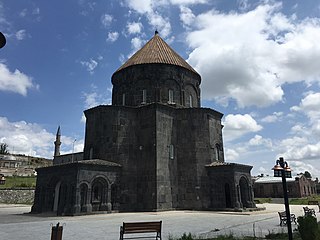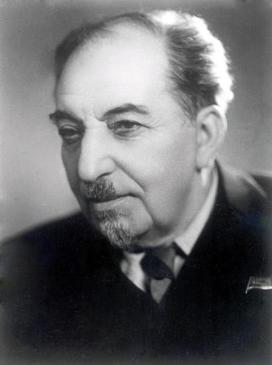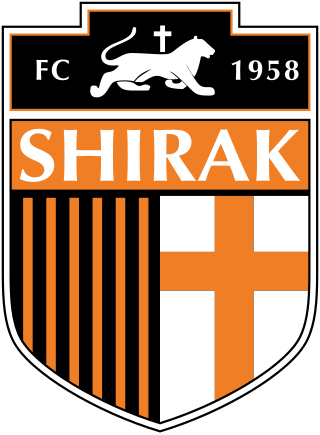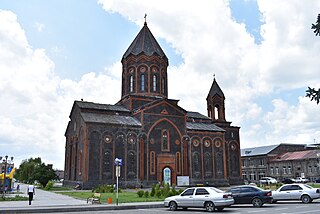
Shirak is a province of Armenia. It is located in the north-west of the country, bordering the provinces of Lori to the east and Aragatsotn to the south and southeast, and the countries of Turkey to the west and Georgia to the north. Its capital and largest city is Gyumri, which is the second largest city in Armenia. It is as much semi-desert as it is mountain meadow or high alpine. In the south, the high steppes merge into mountain terrain, being verdant green in the spring, with hues of reddish brown in the summer. The province is served by the Shirak International Airport of Gyumri.

Kars is a city in northeast Turkey. It is the seat of Kars Province and Kars District. As of 2022, its population was 91,450. Kars, in classical historiography (Strabo), was in the ancient region known as Chorzene, part of the province of Ayrarat in the Kingdom of Armenia, and later the capital of the Bagratid Kingdom of Armenia from 929 to 961. Currently, the mayor of Kars is Türker Öksüz. The city had an Armenian ethnic majority until it was re-captured by Turkish nationalist forces in late 1920.

Gyumri is an urban municipal community and the second-largest city in Armenia, serving as the administrative center of Shirak Province in the northwestern part of the country. By the end of the 19th century, when the city was known as Alexandropol, it became the largest city of Russian-ruled Eastern Armenia with a population above that of Yerevan. The city became renowned as a cultural hub, while also carrying significance as a major center of Russian troops during Russo-Turkish wars of the 19th century.

Hovhannes Shiraz was an Armenian poet.

Avetik Sahaki Isahakyan was a prominent Armenian lyric poet, writer and public activist.

Artik is a town in the Artik Municipality of the Shirak Province of Armenia. As of the 2011 census, the town had a population of 19,534. As per the 2016 official estimate, the population of Artik is around 18,800.

Maralik is a town in the Ani Municipality of the Shirak Province at the northwest of Armenia. As of the 2011 census, the population of the town is 5,398, down from 5,782 reported in the 2001 census. As per the 2016 official estimate, the population of Maralik is around 5,500.

The Erivan Governorate was a province (guberniya) of the Caucasus Viceroyalty of the Russian Empire, with its centеr in Erivan. Its area was 27,830 sq. kilometеrs, roughly corresponding to what is now most of central Armenia, the Iğdır Province of Turkey, and the Nakhchivan exclave of Azerbaijan. At the end of the 19th century, it bordered the Tiflis Governorate to the north, the Elizavetpol Governorate to the east, the Kars Oblast to the west, and Persia and the Ottoman Empire to the south. Mount Ararat and the fertile Ararat Valley were included in the center of the province.

Armenian architecture comprises architectural works with an aesthetic or historical connection to the Armenian people. It is difficult to situate this architectural style within precise geographical or chronological limits, but many of its monuments were created in the regions of historical Armenia, the Armenian Highlands. The greatest achievement of Armenian architecture is generally agreed to be its medieval churches and seventh century churches, though there are different opinions precisely in which respects.
Russians in Armenia are ethnic Russians living in Armenia, where they make up the second largest minority. In the 2022 census, there were 14,074 Russians counted, making up about 0.5% of the whole population of Armenia. A reportage in November 2022 says that more than 300,000 Russians moved to Armenia since the beginning of Russo-Ukainian war.

Anipemza is a village in the Ani Municipality of the Shirak Province of Armenia. The Statistical Committee of Armenia reported its population was 523 in 2010, up from 349 at the 2001 census.

Football Club Shirak, commonly known as Shirak, is an Armenian professional sports club based in Gyumri. Shirak is known for its professional football team which is one of the oldest football clubs in Armenia, having been created in 1958. The club is the only team that participated in all seasons of the Armenian Premier League since its creation in 1992 until 2021. Shirak is one of the more successful clubs in Armenia, having won a total of 11 domestic titles including four Armenian Premier League titles, two Armenian Cup, and five Armenian Super Cup.

The Karin dialect is a Western Armenian dialect originally spoken in and around the city of Erzurum, now located in eastern Turkey.

Officially Dzitoghtsyan House-Museum of Social Life and National Architecture, is a museum in the Kumayri historic district of Gyumri, Armenia. It was founded in 1984 in the Dzitoghtsyan family house, dating back to the 19th century. The museum exhibits elements of the daily urban life of Gyumri, as well as the local cultural and architectural characteristics of the city.

Holy Saviour's Church, is a 19th-century church in Gyumri, Armenia. It occupies the southern side of the Vartanants Square at the centre of Gyumri. It was constructed between 1858 and 1872 and consecrated in 1873.

Sev Berd or Black Fortress is an abandoned Russian imperial fortress in Gyumri, Shirak Province, Armenia. The fortress, which lies 8 kilometres (5.0 mi) from the Turkish border, was built in response to the Russo-Turkish War of 1828–1829. It is a national cultural heritage monument in Armenia.

Poloz Mukuch is a restaurant and prominent beerhouse in Gyumri, the second-largest city in Armenia. It was opened during the 1960s in Soviet Armenia and located in the historic district of Kumayri. It occupies an old mansion built in the 1860s. The beerhouse is named after humorist Mkrtich Melkonyan (1881-1931), a native of Gyumri, better known as Poloz Mukuch.

The Gallery of Mariam and Eranuhi Aslamazyan Sisters is a gallery in Armenia, exhibiting the complete collection of the painting, graphic, ceramic works of Mariam and Eranuhi Aslamazyan sisters. It holds the largest collection of the Aslamazyan sisters' paintings, prints, drawings, and ceramic works of any museum in the world. It is the only museum named after female artists and devoted to female artists in Armenia.

The Hovhannes Shiraz House-Museum was founded in 1983 in the Kumayri historic district of Gyumri, Armenia, and opened in 2003. The museum is devoted to the exhibition and preservation of the Armenian poet Hovhannes Shiraz's personal belongings, manuscripts and works.

Poloz Mukuch was a popular Armenian satirist and fabulist from Gyumri.

































































